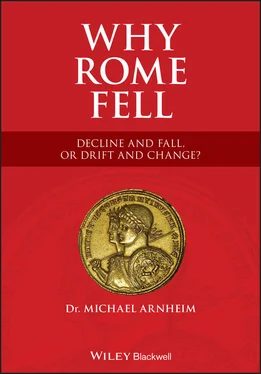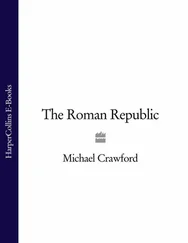Michael Arnheim - Why Rome Fell
Здесь есть возможность читать онлайн «Michael Arnheim - Why Rome Fell» — ознакомительный отрывок электронной книги совершенно бесплатно, а после прочтения отрывка купить полную версию. В некоторых случаях можно слушать аудио, скачать через торрент в формате fb2 и присутствует краткое содержание. Жанр: unrecognised, на английском языке. Описание произведения, (предисловие) а так же отзывы посетителей доступны на портале библиотеки ЛибКат.
- Название:Why Rome Fell
- Автор:
- Жанр:
- Год:неизвестен
- ISBN:нет данных
- Рейтинг книги:3 / 5. Голосов: 1
-
Избранное:Добавить в избранное
- Отзывы:
-
Ваша оценка:
- 60
- 1
- 2
- 3
- 4
- 5
Why Rome Fell: краткое содержание, описание и аннотация
Предлагаем к чтению аннотацию, описание, краткое содержание или предисловие (зависит от того, что написал сам автор книги «Why Rome Fell»). Если вы не нашли необходимую информацию о книге — напишите в комментариях, мы постараемся отыскать её.
Why Rome Fell: Decline and Fall, or Drift and Change?
Why Rome Fell
Why Rome Fell
Why Rome Fell — читать онлайн ознакомительный отрывок
Ниже представлен текст книги, разбитый по страницам. Система сохранения места последней прочитанной страницы, позволяет с удобством читать онлайн бесплатно книгу «Why Rome Fell», без необходимости каждый раз заново искать на чём Вы остановились. Поставьте закладку, и сможете в любой момент перейти на страницу, на которой закончили чтение.
Интервал:
Закладка:
After mocking Augustus for his apparently shifting identities as a young man, Julian, a noted philosopher in his own right, concluded by praising him unstintingly as “wise and temperate” through his supposed conversion to Stoicism (Zeno of Citium being the founder of the Stoic school of philosophy.)
Julian’s portrait of Diocletian was rather different, coupling his pomp with the collegiate nature of the tetrarchy that he established:
Next Diocletian advancing in pomp, bringing with him the two Maximians and my grandfather Constantius. These latter held one another by the hand and did not walk alongside of Diocletian, but formed a sort of chorus round him. And when they wished to run before him as a bodyguard, he prevented them since he did not think himself entitled to more privileges than they. But when he realised that he was growing weary, he gave over to them all the burdens that he carried on his shoulders and admired their unanimity and permitted them to sit far in front of many of their predecessors. (Julian, Caes . 315, Ibid.)
Imperial Power
Was the increased pomp and ceremony of Diocletian’s court indicative of a genuine increase in imperial power, or was it just theater? Edward Gibbon, in his monumental Decline and Fall of the Roman Empire , first published in 1776, saw no real change in the power of the emperor in the transition from Principate to Dominate, just a change in style: “Like the modesty of Augustus, the state maintained by Diocletian was a theatrical representation…. It was the aim of the one to disguise, and the object of the other to display, the unbounded power which the emperors possessed over the Roman world.” (Gibbon, vol I, p. 373.)
J.B. Bury, in his History of the Later Roman Empire from the Death of Theodosius I to the Death of Justinian , first published in 1923, referred to the emperor’s “…gradual and steady usurpation of nearly all the functions of government which Augustus had attributed to the Senate. The republican disguise fell away completely before the end of the third century. Aurelian adopted external fashions which marked a king, not a citizen; and Diocletian and Constantine definitely transformed the state from a republic to an autocracy.” (Bury, 1923, Vol I, p. 5.)
Bury follows Gibbon in referring to “disguise,” but Bury also confusingly talks about a “gradual and steady usurpation.” Disguise of course implies, as Gibbon made clear, that what lay behind the mask was the same throughout, whereas “usurpation” implies an actual escalation in imperial power.
More modern works tend to ignore the question whether Diocletian’s accession marks an increase in imperial power. However, in Christopher Kelly’s Ruling the Later Roman Empire , published in 2004, we come across these passages:
The extent of these changes [between Principate and Dominate] should not be exaggerated. The passage from the Principate to late antiquity was slow and intricate…. The difference between the government of the early and later Empire lies principally in a shift in the way power was organized and exercised, rather than in any great change in the social backgrounds of those involved in the business of government. (Kelly 2004, loc. 1396–8.) The transformation from the Principate to late antiquity was marked by a change in the way the Mediterranean world was ruled. For central government, the formation and promotion of an enlarged and sophisticated bureaucracy held out the attractive possibility of a more detailed and penetrating level of control. More formal structures permitted the development of an elaborate hierarchy of command, the more reliable allocation of tasks, and a greater degree of specialization. (Kelly 2004, loc 2384.)
These remarks, and Kelly’s book as a whole, appear to rely a good deal on John Lydus’s treatise (written in Greek), De Magistratibus reipublicae Romanae (The Magistracies of the Roman State), written in about 550, more than 260 years after Diocletian’s accession in 284. It is primarily a source for the reign of Justinian (r. 527–565), under whom John Lydus, born in 490, served as praetorian prefect until 552. But this was the praetorian prefecture of the East, a century after the end of the Western Empire, which is traditionally dated to the year 476. The amount of light John Lydus’s writings can shed on Diocletian’s reign, or on the West at any time, is minimal.
Another modern writer with an Eastern focus is Peter Brown, who has observed that, “Despite the more drastic assertion of state power that characterized the fourth century, a system of government based upon collusion with the upper classes had continued to idle under a centuries-old momentum.” (Brown 1992, p. 33.)
This model of “collusion with the upper classes” appears to refer to the curial class, who made up the decurions (town councillors) scattered throughout the towns and cities of the Empire. This class was a far cry from the senatorial aristocracy of the West, some members of which had genuine old noble pedigrees. The curial class was even a cut below the equestrian order, which curiales often aspired to join. So, even to call the decurions “upper class” is a stretch. As for “collusion” between Emperor and decurions, this too is misleading. The chapter on Decurions in the Codex Theodosianus (Theodosian Code), the longest chapter in that compilation, contains no fewer than 192 laws. Far from revealing an attempt by the emperor to curry favor with the decurions, these are mostly penal laws prohibiting decurions from seeking to evade their compulsory duties as members of local curias (town councils). Decurions’ prime duty was as tax collectors, and any shortfall had to be made up out of their own pockets, failing which they could suffer forfeiture of their property or even execution.
What about the emperors’ relationship with the actual upper classes, particularly the senatorial aristocracy? Diocletian had a visceral dislike of, or at least total disdain for, the traditional senatorial aristocracy of the West, and he completed the job begun by previous emperors of practically eliminating them from all offices of any importance, a policy that would be reversed by Constantine but only in the West. The distinction between Diocletian and Constantine is crucial. (See Chapter 3.)
Peter Brown’s idea of “collusion with the upper classes” as some sort of ideal model of “autocracy” seems to have been inspired by William Beik in his Absolutism and Society in Seventeenth Century France: State Power and Provincial Aristocracy in Languedoc (1985) (cited by Brown, op. cit ., at p. 23.) Beik’s book is a remarkable example of how myopic concentration on a narrow period and a narrow region can result in a complete misunderstanding of the main issues involved. Why was a supposedly anti-aristocratic reign (i.e. that of Louis XIV) “…sandwiched so tightly between the aristocratic Fronde and the aristocratic eighteenth century?” asks Beik. He sees Louis XIV’s post-Fronde reign as a “success” amounting to a “class alliance” between King and aristocracy. (Beik, loc. 4506.) If Louis XIV’s class alliance was such a success, why was his reign followed by a recurrence of the earlier problems? Beik does not even look at the later period. The Cardinal de Retz, a leading participant in the Fronde, an aristocratic rising against the French Crown, predicted in 1649 that “The parlements, which fanned the flames, will one day be consumed by them.” (Cited by Cobban 1950, p. 64.) This prediction came to pass with a vengeance in 1789, 150 years later, showing that a contemporary had better insight into the forces at work than a historian viewing it with the benefit of hindsight three hundred years later. (See Chapter 6.)
Читать дальшеИнтервал:
Закладка:
Похожие книги на «Why Rome Fell»
Представляем Вашему вниманию похожие книги на «Why Rome Fell» списком для выбора. Мы отобрали схожую по названию и смыслу литературу в надежде предоставить читателям больше вариантов отыскать новые, интересные, ещё непрочитанные произведения.
Обсуждение, отзывы о книге «Why Rome Fell» и просто собственные мнения читателей. Оставьте ваши комментарии, напишите, что Вы думаете о произведении, его смысле или главных героях. Укажите что конкретно понравилось, а что нет, и почему Вы так считаете.












